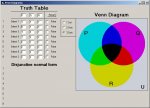I've been searching on different forums as well as google in general and I can't find any realistic way to make a Venn Diagram. All of the plugins/wizards/ideas make simple overlapping circles.
What I'm doing now is creating an circle in Excel base using the value for what I'm needing as the area of the circle. IE 1000 customers in Market A has an area of 1000 units. I then do this for various needed markets so I can get relative sizes for each market. Now I have to go back by hand and find all the overlapping data and eye-ball that overlap to build the venn. Man, this is a bunch of manual work for something so common!
Does anyone have a more automated way to make Venn Diagrams using Access and/or Excel? If not, I've got an idea for a plugin if someone knows how to write it
What I'm doing now is creating an circle in Excel base using the value for what I'm needing as the area of the circle. IE 1000 customers in Market A has an area of 1000 units. I then do this for various needed markets so I can get relative sizes for each market. Now I have to go back by hand and find all the overlapping data and eye-ball that overlap to build the venn. Man, this is a bunch of manual work for something so common!
Does anyone have a more automated way to make Venn Diagrams using Access and/or Excel? If not, I've got an idea for a plugin if someone knows how to write it


